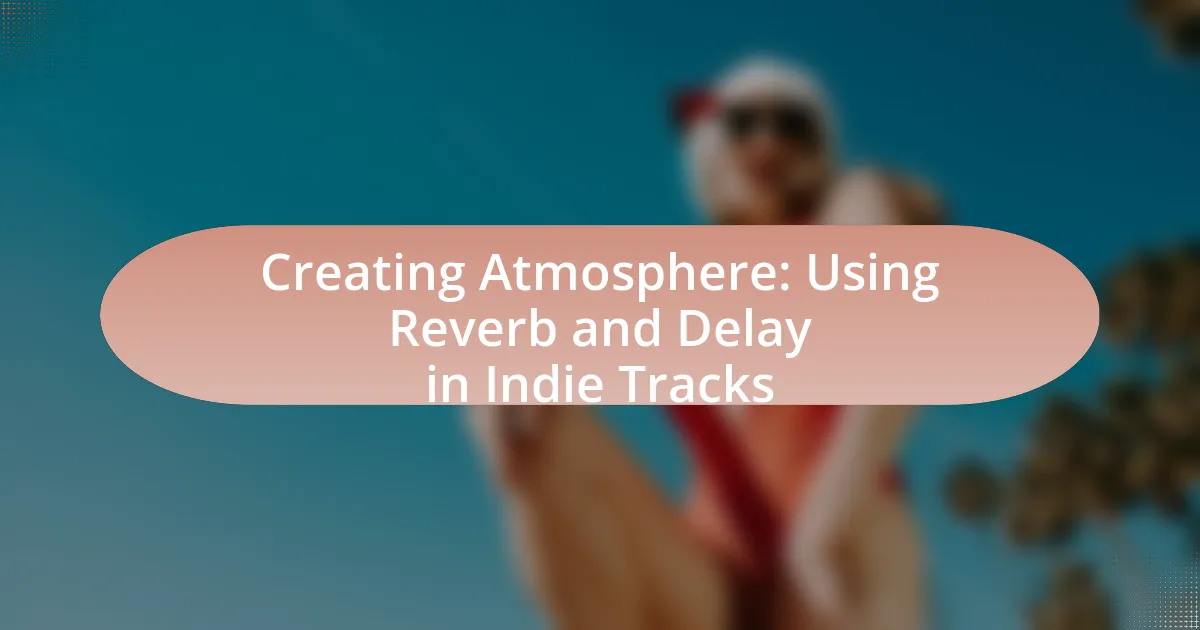The article focuses on the essential roles of reverb and delay in creating atmospheric soundscapes in indie music. It explores how reverb simulates natural sound reflections, enhancing emotional depth and immersion, while delay adds rhythmic complexity and texture. Various types of reverb, such as hall, plate, and room, are discussed alongside techniques for effectively applying these effects to different instruments. The article also highlights best practices for combining reverb and delay, common mistakes to avoid, and recommended tools and plugins for achieving high-quality results in indie music production.

What is the role of reverb and delay in creating atmosphere in indie tracks?
Reverb and delay play crucial roles in creating atmosphere in indie tracks by adding depth and space to the sound. Reverb simulates the natural reflections of sound in a physical space, making instruments and vocals feel more immersive and enveloping. This effect can evoke emotions and enhance the overall mood of a track, contributing to the genre’s characteristic introspective and ethereal qualities. Delay, on the other hand, creates echoes that can add rhythmic complexity and texture, allowing sounds to linger and interact in a way that enriches the listening experience. Together, these effects help to craft a sonic landscape that is both engaging and atmospheric, which is essential in the indie genre where emotional expression and ambiance are often prioritized.
How do reverb and delay contribute to the overall sound of a track?
Reverb and delay significantly enhance the overall sound of a track by adding depth and spatial dimension. Reverb simulates the natural reflections of sound in a physical space, creating a sense of ambiance and fullness, which can make instruments and vocals feel more immersive. Delay, on the other hand, creates echoes that can add rhythmic complexity and texture, allowing sounds to linger and interact in a way that enriches the listening experience. Together, these effects can transform a flat mix into a vibrant soundscape, making it more engaging for the audience.
What are the different types of reverb used in indie music?
The different types of reverb used in indie music include hall reverb, plate reverb, spring reverb, and room reverb. Hall reverb simulates the sound of a large concert hall, providing a lush and expansive sound that is often used in vocal tracks. Plate reverb, which emulates the sound of metal plates vibrating, offers a smooth and warm character, making it suitable for instruments like guitars and vocals. Spring reverb, commonly found in vintage equipment, adds a distinct, bouncy quality that is popular in lo-fi and surf music. Room reverb creates a more intimate sound, mimicking smaller spaces, which can enhance the closeness of a track. These types of reverb contribute to the atmospheric quality that is characteristic of indie music, allowing artists to create unique soundscapes.
How does delay enhance the texture of a song?
Delay enhances the texture of a song by creating a sense of depth and space, allowing individual elements to resonate and interact more dynamically. This effect occurs as delayed sounds blend with the original signal, producing a richer auditory experience. For instance, when a vocal line is accompanied by a delay effect, it can create echoes that fill the sonic space, making the track feel more immersive. Studies in music production have shown that the use of delay can increase the perceived complexity of a sound, as it introduces multiple layers that engage the listener’s attention.
Why are reverb and delay essential for indie music production?
Reverb and delay are essential for indie music production because they create depth and space in a mix, enhancing the overall atmosphere of a track. These effects allow producers to simulate natural environments, making sounds feel more immersive and engaging. For instance, reverb can mimic the acoustics of various spaces, from small rooms to large halls, which adds a sense of realism and emotional resonance to the music. Delay, on the other hand, can create rhythmic patterns and textures that enrich the sonic landscape, contributing to the unique sound that characterizes many indie genres. The use of these effects is supported by the fact that many successful indie tracks utilize them to establish a distinct identity, as seen in the works of artists like Bon Iver and Sufjan Stevens, who effectively employ reverb and delay to enhance their soundscapes.
What emotional effects do reverb and delay create in listeners?
Reverb and delay create feelings of spaciousness and depth in listeners, often evoking emotions such as nostalgia, tranquility, or melancholy. These effects manipulate sound to simulate an environment, enhancing the emotional impact of music. For instance, reverb can make a sound feel distant or ethereal, while delay can create a sense of reflection or contemplation. Research indicates that these auditory effects can influence mood and emotional responses, as they alter the perception of time and space in music, leading to a more immersive listening experience.
How do these effects differentiate indie tracks from other genres?
Reverb and delay effects differentiate indie tracks from other genres by creating a distinct atmospheric quality that emphasizes emotional depth and sonic space. Indie music often employs these effects to enhance the listener’s experience, allowing for a more immersive sound that contrasts with the polished production typical of mainstream genres. For instance, the use of reverb can evoke a sense of nostalgia or intimacy, while delay can add rhythmic complexity and texture. This intentional manipulation of sound contributes to the unique identity of indie music, setting it apart from genres that prioritize clarity and commercial appeal.

What techniques can be used to effectively apply reverb and delay?
To effectively apply reverb and delay, utilize techniques such as adjusting the wet/dry mix, selecting appropriate reverb types, and using tempo-synced delay settings. The wet/dry mix controls the balance between the processed and unprocessed signal, allowing for a more natural sound when set correctly. Choosing the right reverb type, such as plate, hall, or room, can enhance the desired atmosphere, as each type has distinct characteristics that affect the overall sound. Additionally, employing tempo-synced delay settings ensures that the delay repeats align with the track’s rhythm, creating a cohesive sound that complements the music. These techniques are widely recognized in audio production for their effectiveness in enhancing spatial qualities and depth in recordings.
How can reverb be tailored to fit different instruments in a mix?
Reverb can be tailored to fit different instruments in a mix by adjusting parameters such as decay time, pre-delay, and wet/dry mix specific to each instrument’s characteristics. For instance, a shorter decay time and higher pre-delay can enhance clarity for vocals, while a longer decay time can create a lush sound for guitars. Additionally, the wet/dry mix should be balanced to ensure that the reverb complements rather than overwhelms the instrument. This approach is supported by the principle that different instruments occupy unique frequency ranges and spatial characteristics, which can be effectively highlighted through tailored reverb settings.
What parameters should be adjusted for optimal reverb settings?
To achieve optimal reverb settings, the key parameters to adjust include decay time, pre-delay, diffusion, and wet/dry mix. Decay time controls how long the reverb lasts, with longer times creating a more spacious feel, while shorter times can make the sound more intimate. Pre-delay sets the time before the reverb effect begins, allowing for clarity in the initial sound; a typical range is between 10 to 50 milliseconds. Diffusion affects the density of the reverb tail, with higher diffusion creating a smoother sound and lower diffusion resulting in a more distinct echo. Finally, the wet/dry mix balances the reverb effect with the original signal, typically favoring a mix of 20-30% wet for a natural sound. These adjustments are essential for tailoring the reverb to fit the specific atmosphere desired in indie tracks.
How does the choice of reverb type affect the instrument’s presence?
The choice of reverb type significantly affects an instrument’s presence by altering its perceived spatial characteristics and clarity within a mix. Different reverb types, such as hall, room, and plate, create distinct environments that can enhance or diminish an instrument’s prominence. For instance, hall reverb tends to create a lush, expansive sound that can make an instrument feel distant, while room reverb offers a tighter, more intimate sound that can bring an instrument forward in the mix. Research indicates that the decay time and early reflections of the chosen reverb type influence how listeners perceive the instrument’s position and importance in the overall soundscape, thus directly impacting its presence.
What are the best practices for using delay in indie tracks?
The best practices for using delay in indie tracks include setting the delay time to complement the tempo of the song, using feedback to create depth, and applying modulation to add movement. Matching the delay time to the track’s BPM ensures that the echoes align rhythmically, enhancing the overall groove. Utilizing feedback can create a sense of space and richness, making the sound more immersive. Additionally, modulating the delay can introduce variation, preventing the effect from sounding static and enhancing the dynamic quality of the track. These techniques are widely recognized in music production, as they effectively contribute to the atmospheric qualities that are often sought in indie music.
How can timing and feedback settings influence the impact of delay?
Timing and feedback settings significantly influence the impact of delay by determining how long the delayed sound persists and how many repetitions occur. Precise timing settings can create rhythmic effects that enhance the musicality of a track, while varying feedback levels can either create a subtle ambiance or an overwhelming echo, affecting the listener’s perception. For instance, a shorter delay time with low feedback can add depth without cluttering the mix, whereas a longer delay with high feedback can create a dramatic, immersive atmosphere. Studies in audio engineering show that these parameters can alter the emotional response of listeners, making timing and feedback critical in shaping the overall soundscape in indie music.
What creative uses of delay can enhance a song’s atmosphere?
Creative uses of delay that enhance a song’s atmosphere include rhythmic delay, which creates a sense of movement and groove, and ambient delay, which adds depth and space to the sound. Rhythmic delay can sync with the tempo of the track, producing echo effects that complement the beat, while ambient delay can be used to create lush soundscapes by layering delayed signals, resulting in a more immersive listening experience. For instance, artists like Radiohead have effectively utilized these techniques to evoke emotional responses, demonstrating that well-implemented delay can significantly transform the atmosphere of a song.

How can reverb and delay be combined for maximum effect?
Reverb and delay can be combined for maximum effect by carefully adjusting their parameters to create depth and space in a mix. When reverb is applied to a sound, it simulates the natural reflections of sound in a physical space, while delay creates echoes that can enhance rhythmic elements. By setting the delay time to complement the tempo of the track and using a shorter reverb time, the two effects can work together to create a lush, immersive sound without muddying the mix. For instance, using a quarter-note delay with a subtle reverb can add a sense of movement and dimension, making the sound feel more expansive. This technique is commonly used in indie music to evoke emotional responses and enhance the overall atmosphere of a track.
What are the benefits of layering reverb and delay together?
Layering reverb and delay together enhances the spatial quality and depth of sound in music production. This combination allows for a more immersive listening experience, as reverb adds a sense of space and ambiance, while delay creates rhythmic echoes that can complement the musical elements. The interaction between these effects can result in a richer texture, making individual sounds feel more integrated within the mix. Additionally, using both effects can help to fill out frequencies that might otherwise sound thin, providing a fuller sonic landscape that is particularly effective in indie tracks, where atmosphere is crucial.
How can the interplay between reverb and delay create depth in a mix?
The interplay between reverb and delay creates depth in a mix by layering sound elements in a way that simulates a three-dimensional space. Reverb adds a sense of ambiance and fullness, mimicking how sound reflects off surfaces in an environment, while delay creates echoes that can enhance the perception of distance and movement. When used together, reverb can fill the background, providing a lush soundscape, while delay can place specific elements in the foreground, allowing them to stand out. This combination helps to create a more immersive listening experience, as evidenced by the common practice in music production where artists utilize both effects to achieve a rich, textured sound.
What common mistakes should be avoided when using both effects?
Common mistakes to avoid when using reverb and delay in indie tracks include overusing these effects, which can muddy the mix and obscure important elements of the music. Additionally, failing to adjust the parameters of reverb and delay to fit the specific context of the track can lead to an unbalanced sound. For instance, using a long reverb tail in a fast-paced section may create a cluttered audio landscape, while not syncing delay times to the tempo can disrupt the rhythmic flow. These practices can detract from the intended atmosphere and clarity of the track.
What tools and plugins are recommended for achieving great reverb and delay?
Valhalla Room and Valhalla VintageVerb are highly recommended plugins for achieving great reverb, known for their versatility and high-quality sound. For delay, Soundtoys EchoBoy and FabFilter Timeless 3 are excellent choices, offering a range of creative options and precise control over delay parameters. These tools are widely used in the music industry, with Valhalla plugins praised for their lush soundscapes and EchoBoy recognized for its ability to emulate classic delay units.
Which software plugins are popular among indie producers for these effects?
Popular software plugins among indie producers for reverb and delay effects include Valhalla Room, Soundtoys EchoBoy, and FabFilter Pro-R. Valhalla Room is renowned for its high-quality reverb algorithms, making it a favorite for creating lush soundscapes. Soundtoys EchoBoy offers versatile delay options with various styles, allowing producers to achieve everything from vintage echoes to modern delays. FabFilter Pro-R is praised for its intuitive interface and natural-sounding reverb, which helps in crafting atmospheric tracks. These plugins are widely used in the indie music scene due to their effectiveness and ease of use in enhancing the overall sound.
How do hardware units compare to software in terms of sound quality?
Hardware units generally provide superior sound quality compared to software due to their analog circuitry and dedicated components, which can produce richer and more nuanced audio. For instance, hardware reverb units often utilize physical springs or plates, resulting in a more organic sound that many audio professionals prefer. In contrast, software plugins, while versatile and convenient, can sometimes lack the warmth and depth associated with analog processing. Studies have shown that listeners often perceive hardware-generated sounds as more pleasing, with a preference for the subtle imperfections and character that analog devices introduce, which are often absent in digital simulations.
What practical tips can help in mastering reverb and delay in indie music?
To master reverb and delay in indie music, start by understanding the different types of reverb and delay effects available, such as plate, hall, and spring reverb, as well as tape and digital delay. Each type serves a unique purpose in creating depth and space in a mix. For instance, using a short reverb time can add subtle ambiance without muddying the mix, while longer reverb can create a more ethereal sound.
Additionally, utilize pre-delay settings on reverb to separate the initial sound from the reverb tail, enhancing clarity. Experiment with delay feedback settings to create rhythmic patterns that complement the song’s tempo, ensuring the delay does not overpower the main elements.
Moreover, consider the mix’s frequency spectrum; high frequencies can become harsh with excessive reverb, so applying a low-pass filter can help maintain balance. Finally, always use automation to dynamically adjust reverb and delay levels throughout the track, allowing for more expressive transitions and maintaining listener engagement.


